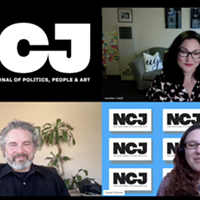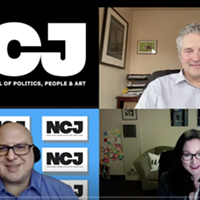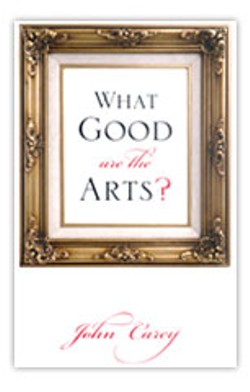[
{
"name": "Top Stories Video Pair",
"insertPoint": "7",
"component": "17087298",
"parentWrapperClass": "fdn-ads-inline-content-block",
"requiredCountToDisplay": "1"
}
]
It's a cold and rainy afternoon. Christmas is upon me, and then the New Year. A time to reflect, and what I've been thinking about is why I write this column (roughly) every two weeks. I often feel like I'm shouting in the wind. Why do I bother writing about art and artists when people are being bombed in Iraq, or murdered in the streets right here at home? Why is art so important?
The day that three jet airplanes filled with people slammed into buildings filled with more people and sent them crashing to the ground, I was scheduled to meet with some folks at the Humboldt Arts Council to help plan a big event. Harvest of the Arts, it was called — "a celebration of creativity" — scheduled for Sept. 30, 2001. I called Debbie Goodwin, then executive director of HAC, and we wondered what the hell we were doing. Were we wasting our time with a bunch of nonsense when the world was going crazy?
What Good Are the Arts? John Carey asks that question in his 2005 book of the same name. When I found out about it, of course I had to get it. It's a great read (if you haven't read it already, I highly recommend you run out and get it as soon as you finish reading this paper), and he makes some scathing comments about the pretentiousness and corruption of the art world. Like anything else that humans do, we often take a good thing and make something rotten out of it, and art is no exception.
My biggest frustration with art is the way it so often is used to divide people. Carey states that, "‘high' art, assures you of your specialness. It inscribes you in the book of life, from which the nameless masses are excluded."
Esoteric art full of obscure symbolism and heady academic references is all too often used as a way to say, "you just don't understand because you're not as sensitive as I am."
And it's not just the rich and powerful excluding the rest of us "riff-raff." All kinds of groups use art or cultural icons as a way to include like-minded people and exclude others, as in, "It's a black thing," or "It's a female thing." While we desperately seek to be understood, sometimes it's comforting to include yourself in a group and push away another group because they just don't get you.
And thus you have the culture wars — "high art" versus popular or "pop art." Each side claiming to be the more enlightened, the more deserving, while the other side is simply not quite human enough to join in camaraderie of the shared expression. So is this all that art is, a way of thumbing your nose at someone and saying, "Yanh, yanh, I'm more aesthetically attuned then you are!"
"The religion of art makes people worse, because it encourages contempt for those considered inartistic," Carey states. But he then goes on to say, "It is time we gave active art a chance to make us better."
Ah, there is hope for us. He turns to Ellen Dissanayake's book, What is Art For? (another book you should read), to help develop his idea of, "art as something done, not consumed, and done by ordinary people, not master-spirits." He also cites authorities who have studied and experimented with the use of art in developing self-esteem, self-discipline, patience and perseverance in young people.
I'm right behind Carey when he encourages "active" art. I have always believed that we are all artists and whatever anyone does with passion and thoughtfulness can be considered art. In fact, although I have to use them all the time, I'm a little uncomfortable with the terms "art" and "artist" because I don't really believe that only a select group of people are artists. Putting one's mark on one's work or surroundings is an inherently human thing to do, a characteristic that is not completely unique to our species, but is certainly rare.
Yet I can't agree with everything Carey says. It's true that art has been commodified and sanctified and all of the other things he accuses art snobs of doing, but there is still a reason to go and see the creative efforts of others. Participation in the arts includes experiencing and reflecting on someone else's expression. There would be little point in creating something that expressed your views on a topic if there were no one willing to "listen" to what you had to say.
So the question still remains, if you're still with me and have accepted that we are all artists: How can art make us better people? What good is it?
It may be that the answer is that the arts are only as important as the human race. Art only matters to us. It is a uniquely human response to the experience of life. It is how we translate ideas and emotions too complex and difficult to summarize, so they must be explored again and again in myriad ways. It is the only way we have of continuing the process of questioning, learning and bettering ourselves as a species.
It does not always lead us to the right answers and it certainly does not always make us better. (Hitler was a painter and a great patron of the arts; Picasso was a misogynist.) But without it, we wouldn't go anywhere. We would not be capable of explaining our collective understanding of existence to our children. This understanding may be faulty, but it is all we have to offer to our children, and without it, they cannot continue on from there but must start all over from square one.
Debbie and I did not meet on Sept. 11, 2001, but we did go ahead with our planning and the Harvest of the Arts happened as scheduled. In the end, I came to the conclusion that it was important because if we didn't do things like that, it would leave only the bombings, war and destruction. I can't stop people from killing each other, but I can do everything in my power to counter it and to celebrate the beauty of life.
Speaking of Art
-

Disaster Response, Crowley, Art in Piles and Salsas
Sep 7, 2023 -

NCJ Preview: Abalone, KHSU and Help in the Storms
Jan 15, 2023 -

NCJ Preview: Potter Plans, Measure S, Masks and Analog Art
Feb 12, 2022 - More »
Comments
Showing 1-1 of 1
more from the author
-
Obama and the Arts
Do we really need -- or want -- a Ministry of Culture?
- Feb 5, 2009
-
Humboldt Wild
By Arleen Olson. Self-published.
- Feb 5, 2009
-
Colors Flowing Like Water
Rande Rothman's silk paintings
- Jan 15, 2009
- More »
































